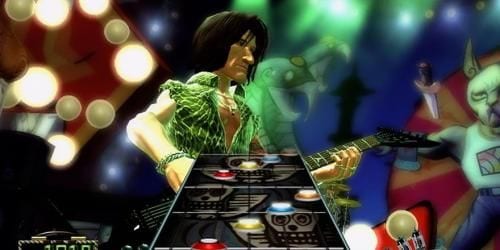
Have you ever actually met a hardcore Aerosmith fan? I haven’t, which is sort of strange considering how many hits they’ve had over the last three decades. Most bands of their superstar caliber — Led Zeppelin, The Rolling Stones, U2, Black Sabbath, hell, even Rush — maintain rabid followings amongst certain fans. But for whatever reason, Aerosmith doesn’t usually inspire more than a “Yeah, I guess I like some of their songs,” from most music listeners.
Perhaps it’s because over the last two decades they’ve become almost a theme park band – settling for videos starring a teenage Alicia Silverstone, cheesy movie soundtracks, Super Bowl appearances, and a comfortable crowd-pleasing blues rock sound that isn’t all that distinctive or interesting.
For better or for worse, Aerosmith cleaned up its act in the ’80s and committed a sin worse than drug and alcohol abuse — they went corporate.
It seems appropriate then, considering the band they got to star in the game, that the new addition to the Guitar Hero series is decidedly mediocre and uninspiring. Despite a few interesting new things, Guitar Hero: Aerosmith really isn’t much more than a Guitar Hero III expansion pack with a thin coat of Aerosmith paint splashed on.
The familiar “hit the colored buttons and strum in time” gameplay is the same, the career, multiplayer and online modes and menu remain unchanged, and you’ll even find that the guitars and some of the characters from Guitar Hero III are there. The new stuff comes in the form of Aerosmith character models, guitars modeled after Joe Perry’s collection, and video interviews with the band between setlists (that for some reason weren’t recorded in widescreen so there are black bars on the side).
The usual Guitar Hero song tiers highlight Aerosmith’s career chronologically in a quasi-VH1: Behind the Music way (minus the rehab of course). You start out humbly at Nipmuc Regional High School and go all the way to the Super Bowl halftime show and the Rock and Roll Hall of Fame. Each of these locations is used as the backdrop for the set and introduced by a short video of band members reminiscing fondly about the old days. Guitar Hero: Aerosmith does actually break up the Aerosmith-centric song list in a clever way: it starts out sets with “opening bands” that Aerosmith actually toured with at some point, lik Stone Temple Pilots (whose “Sex Type Thing” feels slightly out of place here), Cheap Trick, and (arguably the best addition) Run-DMC. Unfortunately, however, the non-Aerosmith songs tend to be cover versions of the originals, and they’re of varying quality.
The Aerosmith songs are also a mixed bag. The band’s early rockers “Sweet Emotion” and “Dream On” are no-brainers and they’re the best songs on the game. Other pre-1984 classics like “Toys in the Attic”, “Uncle Salty” and “Draw the Line” also make the cut. Late 80’s hits like “Love in an Elevator,” “Rag Doll,” and “Walk This Way” are also welcome additions. The most recent songs are “Pink” and “Beyond Beautiful” from the band’s 2001 album Just Push Play.
No doubt that many people will complain that Neversoft left off most of Aerosmith’s hit ballads like “Cryin'” and the weepy “I Don’t Want to Miss a Thing” from the Armageddon soundtrack, but to me it seems like the right call. I don’t think power ballads are meant to be played on Guitar Hero. I also can’t say I’m sorry to see the annoying “Dude Likes a Lady” omitted.
In all, the career mode consists of 31 songs, with each set of five made up of three tracks by the title group and two by the other bands. You can also unlock a few bonus songs Aerosmith or Joe Perry Project tunes, but that’s still only about 40 total songs. That’s not many considering it’s a full priced $60 game and Activision says that no downloadable tracks will be made available.
There would have been two ways to make Guitar Hero: Aerosmith worth buying and Neversoft took neither route unfortunately. The first idea is an obvious one, and it would be to release Guitar Hero: Aerosmith as either a budget priced expansion pack to Guitar Hero III or as downloadable content on Xbox Live or the Playstation Network. The other approach could have been to take the “Play Aerosmith’s career” idea much further and turned it into a Guitar Hero role-playing game where you could set up practice spaces, hire a manager, stave off crazy groupies, deal with the temptations of the rock ‘n’ roll lifestyle and build up your instrument playing skills.
Instead, what Neversoft has built is another Guitar Hero game that will appeal almost exclusively to either devoted Aerosmith fans or fans of the Guitar Hero franchise itself. I think, sadly, that there might be many more of the latter.

![Call for Papers: All Things Reconsidered [MUSIC] May-August 2024](https://www.popmatters.com/wp-content/uploads/2024/04/all-things-reconsidered-call-music-may-2024-720x380.jpg)



